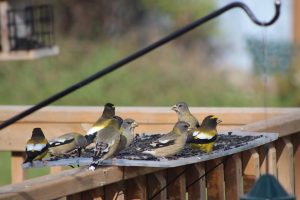 Not all bird species fly south for the winter, and not all of those that do come as far as Peterborough. Last year was what was called an “irruption year” for birds. Many bird species, such as Pine Siskins, the 2 redpoll species, and Bohemian Waxwings came here in greater numbers than in a typical winter.
Not all bird species fly south for the winter, and not all of those that do come as far as Peterborough. Last year was what was called an “irruption year” for birds. Many bird species, such as Pine Siskins, the 2 redpoll species, and Bohemian Waxwings came here in greater numbers than in a typical winter.
It’s looking like this year will be a good year for Evening Grosbeaks, a species that rarely comes this far south during the winter. Many have already been reported by local birders. These stunning birds are about robin-sized, but a bit rounder in the body and shorter in the tail. They’re yellow with black wings and a dark head. They have large, distinct white patches on their wings, and, as their name suggests, large, thick beaks, like those of the more common local Rose-breasted Grosbeak. Their vocalizations are variable and sound like mini laser guns from Star Wars.
Evening Grosbeaks tend to prefer conifers over deciduous trees and hang out in large flocks. They eat large seeds, so you may want to add some hulled peanuts to your feeding station. They’re wary and will tend to take off together when disturbed, so are best enjoyed from the warmth of the indoors.
Why so many this year? Perhaps this was a particularly good food year up north, and more young successfully fledged. This could result in more birds than there’s food for, requiring some to head farther south than usual. Another, perhaps more likely, explanation, is that there is a scarcity of suitable food for them farther north, so a larger number of them have to move farther south to find food.
To learn more about Evening Grosbeaks (or any other North American birds), visit Cornell University’s All About Birds. You can also ask to join The Facebook group, Peterborough Ontario Birds, moderated by local Ornithologist, Andrew Jobes.
(photos: single male on snowy feeder: Nora Mickee; flock on platform feeder: Sarah McGuire-Sherritt)
